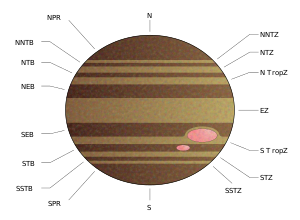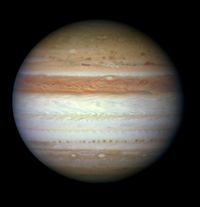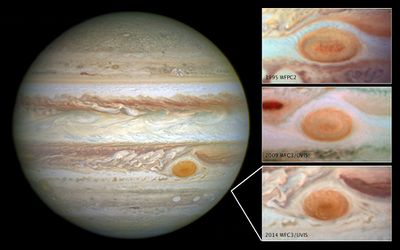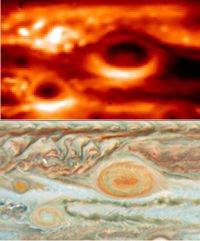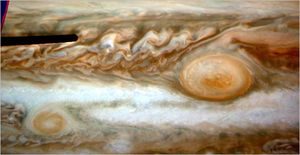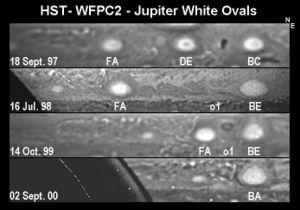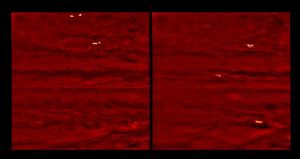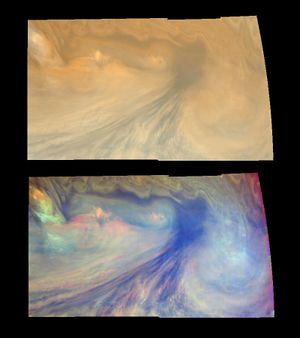الغلاف الجوي للمشترى
الغلاف الجوي للمشترى هو أكبر غلاف جوي كوكبي في النظام الشمسي. يتكون معظمه من الهيدروجين الجزيئي والهليوم بنسب شمسية تقريبية؛ توجد مركبات كيميائية أخرى موجودة فقط بكميات ضئيلة وتشمل الميثان، الأمونيا، كبريتيد الهيدروجين والماء. بالرغم من أنه يعتقد باستقرار الماء في عمق الغلاف الجوي، إلا أن تركيزاته المقاسة مباشرة منخفضة جداً. الأكسجين، النتروجين، الكبريت، والغازات النبيلة متوافرة في الغلاف الجوي للمشترى بكميات تتجاوز القيم الشمسية بثلاثة أضعاف.[1]
. . . . . . . . . . . . . . . . . . . . . . . . . . . . . . . . . . . . . . . . . . . . . . . . . . . . . . . . . . . . . . . . . . . . . . . . . . . . . . . . . . . . . . . . . . . . . . . . . . . . . . . . . . . . . . . . . . . . . . . . . . . . . . . . . . . . . . . . . . . . . . . . . . . . . . . . . . . . . . . . . . . . . . . .
التركيب الرأسي
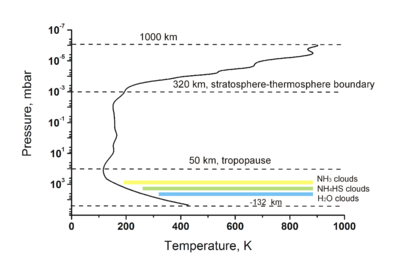
التكوين الكيميائي
| العنصر | الشمس | المشترى/الشمس |
| الهليوم/الهيدروجين | 0.0975 | 0.807 ± 0.02 |
| النيوم/الهيدروجين | 1.23 × 10−4 | 0.10 ± 0.01 |
| الأرگون/الهيدروجين | 3.62 × 10−6 | 2.5 ± 0.5 |
| الكريپتون/الهيدروجين | 1.61 × 10−9 | 2.7 ± 0.5 |
| الزينون/الهيدروجين | 1.68 × 10−10 | 2.6 ± 0.5 |
| الكربون/الهيدروجين | 3.62 × 10−4 | 2.9 ± 0.5 |
| N/الهيدروجين | 1.12 × 10−4 | 3.6 ± 0.5 (8 بار)
3.2 ± 1.4 (9–12 بار) |
| O/الهيدروجين | 8.51 × 10−4 | 0.033 ± 0.015 (12 بار)
0.19–0.58 (19 بار) |
| P/الهيدروجين | 3.73 × 10−7 | 0.82 |
| S/الهيدروجين | 1.62 × 10−5 | 2.5 ± 0.15 |
| النسبة | الشمس | المشترى |
| 13C/12C | 0.011 | 0.0108 ± 0.0005 |
| 15N/14N | <2.8 × 10−3 | 2.3 ± 0.3 × 10−3
(0.08–2.8 bar) |
| 36Ar/38Ar | 5.77 ± 0.08 | 5.6 ± 0.25 |
| 20Ne/22Ne | 13.81 ± 0.08 | 13 ± 2 |
| 3He/4He | 1.5 ± 0.3 × 10−4 | 1.66 ± 0.05 × 10−4 |
| D/H | 3.0 ± 0.17 × 10−5 | 2.25 ± 0.35 × 10−5 |
المناطق، الأحزمة والنفاثات
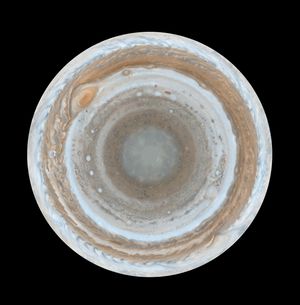
نطاقات معينة

الديناميكا
النماذج الضحلة
النماذج العميقة

الحرارة الداخلية
خصائص منفصلة
الدوامات

. . . . . . . . . . . . . . . . . . . . . . . . . . . . . . . . . . . . . . . . . . . . . . . . . . . . . . . . . . . . . . . . . . . . . . . . . . . . . . . . . . . . . . . . . . . . . . . . . . . . . . . . . . . . . . . . . . . . . . . . . . . . . . . . . . . . . . . . . . . . . . . . . . . . . . . . . . . . . . . . . . . . . . . .
البقعة الحمراء العظيمة
البقعة الحمراء العظيمة تقع في الحزام الجنوبي المعتدل من الكوكب وهي أعظم إعصار في المجموعة الشمسية. شكل البقعة بيضاوي وذات لون أحمر يتغير من الوردي الفاتح الى الأحمر البرتقالي (قد يكون اللون الاحمر ناجما عن الفسفور). تغطي البقعة الحمراء العظيمة مساحة كبيرة من سطح المشتري ( وهى ليست ثابتة الحجم) يقدر طولها بنحو 40,000 كيلو متر وعرضها بنحو 14,000 كيلو متر فبإمكانها إبتلاع الكرة الأرضية برمتها وتدور عكس اتجاة عقارب الساعة في ستة ايام.
من المحتمل أن هذة البقعة عرفت من القرن السابع عشر الميلادي لكنها برزت ووصفت على انها ذات لون أحمر سنة 1878 وبعد سنة 1882 بدأت تختفي لكن الفجوة التى خلفتها ورائها ظلت خافتة ومنذ ذلك الوقت صارت البقعة الحمراء تظهر دورياً. وفي سنة 1959 تلاشت عن الأنظار لكنها عادت واضحة سنة 1960 من جديد.[4]
أكدت المسابر الفضائية أنها حدث جوي وقدمت صوراً وتفاصيل عنها ويعتقد العلماء انها تكونت من خلال غازات دافئة تصاعدت من اسفل غيوم المشتري.
البقعة البيضاوية
العواصف والوميض
في المشتري رياح قوية وسريعة جداً تتواجد على شكل رزم عرضية متراصفة على طول الكوكب، والريح في كل رزمة تهب بالاتجاه المعاكس من الرزمة المقابلة. الاختلاف الكيمائي والحراري البسيط بين كل رزمة وأخرى هو السبب في التنوع اللوني الذي يعطي للمشتري (و باقي الكواكب الغازية الأخرى) شكلها المدهش، والرزم الملونة الخفيفة تدعى بالمناطق (Zones) والغامقة تدعى بالأحزمة (Belts). الرزم معروفة منذ بعض الوقت على المشتري ولكن الأعاصير المركبة بين الحدود الفاصلة للرزم لم تر إلا عن طريق مركبة فوياجر 1, والمعلومات من مسبار جاليليو أكدت أن سرعة الرياح أعلى من 400 ميل في الساعة وتمتد لأسفل حد وصل إليه المسبار حتى أنها ممكن أن تمتد إلى ألاف الكيلومترات لداخل الكوكب. الطقس على المشتري عاصف وقاسي بشكل كبير ورياح المشتري تهب لمناطق بعيدة جداً على الكوكب وذلك بسبب حرارة الكوكب الداخلية.
الاضطرابات
البقع الساخنة
التاريخ الرصدي

دراسات البقعة الحمراء العظيمة

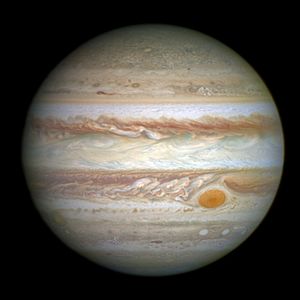
. . . . . . . . . . . . . . . . . . . . . . . . . . . . . . . . . . . . . . . . . . . . . . . . . . . . . . . . . . . . . . . . . . . . . . . . . . . . . . . . . . . . . . . . . . . . . . . . . . . . . . . . . . . . . . . . . . . . . . . . . . . . . . . . . . . . . . . . . . . . . . . . . . . . . . . . . . . . . . . . . . . . . . . .
التشكيلات البيضاوية البيضاء
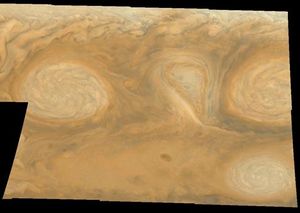
انظر أيضاً
- Comet Shoemaker–Levy 9
- كوكب خارج النظام الشمسي (الكثير أكبر من المريخ)
- گاليليو مسبار الغلاف الجوي
- المسبار جونو
- 2009 Jupiter impact event
- 2010 Jupiter impact event
- Ulysses (spacecraft)
- ڤويدجر-1، ڤويدجر-2
الهوامش
- ^ The scale height sh is defined as sh = RT/(Mgj), where R = 8.31 J/mol/K is the gas constant, M ≈ 0.0023 kg/mol is the average molar mass in the Jovian atmosphere,[2] T is temperature and gj ≈ 25 m/s2 is the gravitational acceleration at the surface of Jupiter. As the temperature varies from 110 K in the tropopause up to 1000 K in the thermosphere,[2] the scale height can assume values from 15 to 150 km.
- ^ The Galileo atmospheric probe failed to measure the deep abundance of oxygen, because the water concentration continued to increase down to the pressure level of 22 bar, when it ceased operating. While the actually measured oxygen abundances are much lower than the solar value, the observed rapid increase of water content of the atmosphere with depth makes it highly likely that the deep abundance of oxygen indeed exceeds the solar value by a factor of about 3—much like other elements.[1]
- ^ Various explanations of the overabundance of carbon, oxygen, nitrogen and other elements have been proposed. The leading one is that Jupiter captured a large number of icy planetesimals during the later stages of its accretion. The volatiles like noble gases are thought to have been trapped as clathrate hydrates in water ice.[1]
المصادر
- ^ أ ب ت ث ج Atreya Mahaffy Niemann et al. 2003.
- ^ أ ب ت خطأ استشهاد: وسم
<ref>غير صحيح؛ لا نص تم توفيره للمراجع المسماةSieff1998 - ^ Harrington, J.D.; Weaver, Donna; Villard, Ray (May 15, 2014). "Release 14-135 - NASA's Hubble Shows Jupiter's Great Red Spot is Smaller than Ever Measured". NASA. Retrieved May 16, 2014.
- ^ مؤمن, عبد الأمير (2006). قاموس دار العلم الفلكي. بيروت، لبنان: دار العلم للملايين.
{{cite book}}: Cite has empty unknown parameter:|طبعة أولى coauthors=(help)
المراجع
- DOI:10.1016/S0032-0633(99)00047-1 10.1016/S0032-0633(99)00047-1
This citation will be automatically completed in the next few minutes. You can jump the queue or expand by hand - DOI:10.1016/S0032-0633(02)00144-7 10.1016/S0032-0633(02)00144-7
This citation will be automatically completed in the next few minutes. You can jump the queue or expand by hand - DOI:10.1007/s11214-005-1951-5 10.1007/s11214-005-1951-5
This citation will be automatically completed in the next few minutes. You can jump the queue or expand by hand - DOI:10.1016/j.pss.2004.04.002 10.1016/j.pss.2004.04.002
This citation will be automatically completed in the next few minutes. You can jump the queue or expand by hand - DOI:10.1126/science.1147912 10.1126/science.1147912
This citation will be automatically completed in the next few minutes. You can jump the queue or expand by hand - Beatty, J.K. (2002). "Jupiter's Shrinking Red Spot". Sky and Telescope. 103 (4): 24.
- Beebe, R. (1997). Jupiter the Giant Planet (2nd ed.). Washington: Smithsonian Books. ISBN 1-56098-685-9. OCLC 224014042.
- DOI:10.1029/1998RG000046
This citation will be automatically completed in the next few minutes. You can jump the queue or expand by hand - Busse, F.H. (1976). "A simple model of convection in the Jovian atmosphere". Icarus. 29 (2): 255–260. Bibcode:1976Icar...29..255B. doi:10.1016/0019-1035(76)90053-1.
- DOI:10.1016/S0032-0633(02)00145-9 10.1016/S0032-0633(02)00145-9
This citation will be automatically completed in the next few minutes. You can jump the queue or expand by hand - Fletcher, Leigh N.; Orton,, G.S.; Mousis, O.; Yanamandra-Fisher, P.; Parrish, P.D.; Irwin, P.G.J.; Fisher, B.M.; Vanzi, L.; Fujiyoshi, T.; et al. (2010). "Thermal structure and composition of Jupiter's Great Red Spot from high-resolution thermal imaging" (PDF). Icarus. 208 (1): 306–328. Bibcode:2010Icar..208..306F. doi:10.1016/j.icarus.2010.01.005.
{{cite journal}}: Explicit use of et al. in:|last3=(help)CS1 maint: extra punctuation (link) - Go, C.Y.; de Pater, I.; Wong M.; Lockwood; Marcus; Asay-Davis; Shetty; et al. (2006). "Evolution Of The Oval Ba During 2004–2005". Bulletin of the American Astronomical Society. 38: 495. Bibcode:2006DPS....38.1102G.
{{cite journal}}: Explicit use of et al. in:|author3=(help) - Graney, C. M. (2010). "Changes in the Cloud Belts of Jupiter, 1630-1664, as reported in the 1665 Astronomia Reformata of Giovanni Battista Riccioli". Baltic Astronomy. 19: 266. Bibcode:2010BaltA..19..265G.
- Guillot, T. (1999). "A comparison of the interiors of Jupiter and Saturn". Planetary and Space Science. 47 (10–11): 1183–1200. arXiv:astro-ph/9907402. Bibcode:1999P&SS...47.1183G. doi:10.1016/S0032-0633(99)00043-4.
- Hammel, H.B.; Lockwood, G.W.; Mills, J.R.; Barnet, C.D. (1995). "Hubble Space Telescope Imaging of Neptune's Cloud Structure in 1994". Science. 268 (5218): 1740–1742. Bibcode:1995Sci...268.1740H. doi:10.1126/science.268.5218.1740. PMID 17834994.
- Heimpel, M.; Aurnou, J.; Wicht, J. (2005). "Simulation of equatorial and high-latitude jets on Jupiter in a deep convection model" (PDF). Nature. 438 (7065): 193–196. Bibcode:2005Natur.438..193H. doi:10.1038/nature04208. PMID 16281029.
- Hockey, T. (1999). Galileo's Planet: Observing Jupiter Before Photography. Bristol, Philadelphia: Institute of Physics Publishing. ISBN 0-7503-0448-0. OCLC 39733730.
- Ingersoll, A.P.; Dowling, T.E.; Gierasch, P.J.; et al. (2004). "Dynamics of Jupiter's Atmosphere" (PDF). In Bagenal, F.; Dowling, T.E.; McKinnon, W.B. (ed.). Jupiter: The Planet, Satellites and Magnetosphere. Cambridge: Cambridge University Press. ISBN 0-521-81808-7.
{{cite encyclopedia}}: Explicit use of et al. in:|author3=(help)CS1 maint: multiple names: editors list (link) - Ingersoll, A.P.; Cuzzi, J.N. (1969). "Dynamics of Jupiter's cloud bands". Journal of the Atmospheric Sciences. 26 (5): 981–985. Bibcode:1969JAtS...26..981I. doi:10.1175/1520-0469(1969)026<0981:DOJCB>2.0.CO;2.
- Irwin, P. (2003). Giant Planets of Our Solar System. Atmospheres, Composition, and Structure. Springer and Praxis. ISBN 978-3-540-00681-7.
- Kunde, V.G.; Flasar, F.M.; Jennings, D.E.; et al. (2004). "Jupiter's Atmospheric Composition from the Cassini Thermal Infrared Spectroscopy Experiment". Science. 305 (5690): 1582–1586. Bibcode:2004Sci...305.1582K. doi:10.1126/science.1100240. PMID 15319491.
{{cite journal}}: Explicit use of et al. in:|author3=(help) - Low, F.J. (1966). "Observations of Venus, Jupiter, and Saturn at λ20 μ". Astronomical Journal. 71: 391. Bibcode:1966AJ.....71R.391L. doi:10.1086/110110.
- McKim, R.J. (1997). "P. B. Molesworth's discovery of the great South Tropical Disturbance on Jupiter, 1901". Journal of the British Astronomical Association. 107 (5): 239–245. Bibcode:1997JBAA..107..239M.
- DOI:10.1007/s11214-005-1960-4 10.1007/s11214-005-1960-4
This citation will be automatically completed in the next few minutes. You can jump the queue or expand by hand - Noll, K.S.; McGrath, M.A.; Weaver, H.A.; Yelle, R.V.; Trafton, L.M.; Atreya, S.K.; Caldwell, J.J.; Barnet, C.; Edgington, S. (1995). "HST Spectroscopic Observations of Jupiter Following the Impact of Comet Shoemaker-Levy 9". Science. 267 (5202): 1307–1313. Bibcode:1995Sci...267.1307N. doi:10.1126/science.7871428. PMID 7871428.
- DOI:10.1016/0019-1035(90)90155-3 10.1016/0019-1035(90)90155-3
This citation will be automatically completed in the next few minutes. You can jump the queue or expand by hand - Reese, E.J.; Solberg, H.G. (1966). "Recent measures of the latitude and longitude of Jupiter's red spot". Icarus. 5 (1–6): 266–273. Bibcode:1966Icar....5..266R. doi:10.1016/0019-1035(66)90036-4.
- Ridpath, I. (1998). Norton's Star Atlas and Reference Handbook (19th ed.). Harlow: Addison Wesley Longman. p. 107. ISBN 0-582-35655-5.
- Rogers, J.H. (1995). The Giant Planet Jupiter. Cambridge: Cambridge University Press. ISBN 0-521-41008-8. OCLC 219591510.
- Rogers, J.H.; Metig, H.J. (2001). "Jupiter in 1998/99" (PDF). Journal of the British Astronomical Association. 111 (6): 321–332. Bibcode:2001JBAA..111..321R.
- Rogers, J.H. (2003). "Jupiter in 1999/2000. II: Infrared wavelengths" (PDF). Journal of the British Astronomical Association. 113 (3): 136–140. Bibcode:2003JBAA..113..136R.
- Rogers, J.H. (2008). "The accelerating circulation of Jupiter's Great Red Spot" (PDF). Journal of the British Astronomical Association. 118 (1): 14–20. Bibcode:2008JBAA..118...14R.
- Sanchez-Lavega, A.; Orton, G.S.; Morales R.; et al. (2001). "The Merger of Two Giant Anticyclones in the Atmosphere of Jupiter". Icarus. 149 (2): 491–495. Bibcode:2001Icar..149..491S. doi:10.1006/icar.2000.6548.
{{cite journal}}: Explicit use of et al. in:|author3=(help) - Sanchez-Lavega, A.; Orton, G.S.; Hueso, S.; et al. (2008). "Depth of the strong Jovian jet from a planetary scale disturbance driven by storms". Nature. 451 (7177): 437–440. Bibcode:2008Natur.451..437S. doi:10.1038/nature06533. PMID 18216848.
{{cite journal}}: Explicit use of et al. in:|author3=(help) - Seiff, A.; Kirk, D.B.; Knight, T.C.D.; et al. (1998). "Thermal structure of Jupiter's atmosphere near the edge of a 5-μm hot spot in the north equatorial belt". Journal of Geophysical Research. 103 (E10): 22857–22889. Bibcode:1998JGR...10322857S. doi:10.1029/98JE01766.
{{cite journal}}: Explicit use of et al. in:|author3=(help) - Smith, B.A.; Soderblom, L.A.; Johnson, T.V.; et al. (1979). "The Jupiter system through the eyes of Voyager 1". Science. 204 (4396): 951–957, 960–972. Bibcode:1979Sci...204..951S. doi:10.1126/science.204.4396.951. PMID 17800430.
{{cite journal}}: Explicit use of et al. in:|author3=(help) - Stone, P.H. (1974). "On Jupiter's Rate of Rotation" (PDF). Journal of Atmospheric Sciences. 31 (5): 1471–1472. Bibcode:1974JAtS...31.1471S. doi:10.1175/1520-0469(1974)031<1471:OJROR>2.0.CO;2.
- Vasavada, A.R.; Showman, A. (2005). "Jovian atmospheric dynamics: An update after Galileo and Cassini". Reports on Progress in Physics. 68 (8): 1935–1996. Bibcode:2005RPPh...68.1935V. doi:10.1088/0034-4885/68/8/R06.
- West, R.A.; Baines, K.H.; Friedson, A.J.; et al. (2004). "Jovian Clouds and Haze". In Bagenal, F.; Dowling, T.E.; McKinnon, W.B. (ed.). Jupiter: The Planet, Satellites and Magnetosphere (PDF). Cambridge: Cambridge University Press.
{{cite book}}: Explicit use of et al. in:|author3=(help)CS1 maint: multiple names: editors list (link) - Yelle, R.V.; Miller, S. (2004). "Jupiter's Thermosphere and Ionosphere" (PDF). In Bagenal, F.; Dowling, T.E.; McKinnon, W.B. (ed.). Jupiter: The Planet, Satellites and Magnetosphere. Cambridge: Cambridge University Press.
{{cite encyclopedia}}: CS1 maint: multiple names: editors list (link)
قراءات إضافية
- [Numerous authors] (1999). Beatty, Kelly J.; Peterson, Carolyn Collins; Chaiki, Andrew (ed.). The New Solar System (4th ed.). Massachusetts: Sky Publishing Corporation. ISBN 0-933346-86-7. OCLC 39464951.
{{cite book}}: CS1 maint: multiple names: editors list (link) - Peek, Bertrand M. (1981). The Planet Jupiter: The Observer's Handbook (Revised ed.). London: Faber and Faber Limited. ISBN 0-571-18026-4. OCLC 8318939.
- Yang, Sarah (April 21, 2004). "Researcher predicts global climate change on Jupiter as giant planet's spots disappear". UC Berkeley News. Archived from the original on 9 June 2007. Retrieved 2007-06-14.
{{cite news}}: Unknown parameter|deadurl=ignored (|url-status=suggested) (help) - Youssef, Ashraf; Marcus, Philip S. (2003). "The dynamics of jovian white ovals from formation to merger". Icarus. 162 (1): 74–93. Bibcode:2003Icar..162...74Y. doi:10.1016/S0019-1035(02)00060-X.
{{cite journal}}: CS1 maint: multiple names: authors list (link) - Williams, Gareth P. (1975). "Jupiter's atmospheric circulation" (PDF). Nature. 257 (5529): 778. Bibcode:1975Natur.257..778W. doi:10.1038/257778a0.
- Williams, Gareth P. (1978). "Planetary Circulations: 1. Barotropic representation of Jovian and terrestrial turbulence" (PDF). Journal of the Atmospheric Sciences. 35 (8): 1399–1426. Bibcode:1978JAtS...35.1399W. doi:10.1175/1520-0469(1978)035<1399:PCBROJ>2.0.CO;2.
- Williams, Gareth P. (1985). "Jovian and comparative atmospheric modeling" (PDF). Advances in Geophysics. Advances in Geophysics. 28A: 381–429. Bibcode:1985AdGeo..28..381W. doi:10.1016/S0065-2687(08)60231-9. ISBN 978-0-12-018828-4.
- Williams, Gareth P. (1997). "Planetary vortices and Jupiter's vertical structure" (PDF). Journal of Geophysical Research. 102 (E4): 9303–9308. Bibcode:1997JGR...102.9303W. doi:10.1029/97JE00520.
- Williams, Gareth P. (1996). "Jovian Dynamics. Part I: Vortex stability, structure, and genesis" (PDF). Journal of the Atmospheric Sciences,. 53 (18): 2685–2734. Bibcode:1996JAtS...53.2685W. doi:10.1175/1520-0469(1996)053<2685:JDPVSS>2.0.CO;2.
{{cite journal}}: CS1 maint: extra punctuation (link) - Williams, Gareth P. (2002). "Jovian Dynamics.Part II: The genesis and equilibration of vortex sets" (PDF). Journal of the Atmospheric Sciences,. 59 (8): 1356–1370. Bibcode:2002JAtS...59.1356W. doi:10.1175/1520-0469(2002)059<1356:JDPITG>2.0.CO;2.
{{cite journal}}: CS1 maint: extra punctuation (link) - Williams, Gareth P. (2003). "Jovian Dynamics, Part III: Multiple, migrating, and equatorial jets" (PDF). Journal of the Atmospheric Sciences,. 60 (10): 1270–1296. Bibcode:2003JAtS...60.1270W. doi:10.1175/1520-0469(2003)60<1270:JDPIMM>2.0.CO;2.
{{cite journal}}: CS1 maint: extra punctuation (link) - Williams, Gareth P. (2003). "Super Circulations" (PDF). Bulletin of the American Meteorological Society. 84 (9): 1190.
- Williams, Gareth P. (2003). "Barotropic instability and equatorial superrotation" (PDF). Journal of the Atmospheric Sciences. 60 (17): 2136–2152. Bibcode:2003JAtS...60.2136W. doi:10.1175/1520-0469(2003)060<2136:BIAES>2.0.CO;2.
- Williams, Gareth P. (2003). "Jet sets" (PDF). Journal of the Meteorological Society of Japan. 81 (3): 439–476. doi:10.2151/jmsj.81.439.
- Williams, Gareth P. (2006). "Equatorial Superrotation and Barotropic Instability: Static Stability Variants" (PDF). Journal of the Atmospheric Sciences. 63 (5): 1548–1557. Bibcode:2006JAtS...63.1548W. doi:10.1175/JAS3711.1.
وصلات خارجية
 Media related to الغلاف الجوي للمشترى at Wikimedia Commons
Media related to الغلاف الجوي للمشترى at Wikimedia Commons


